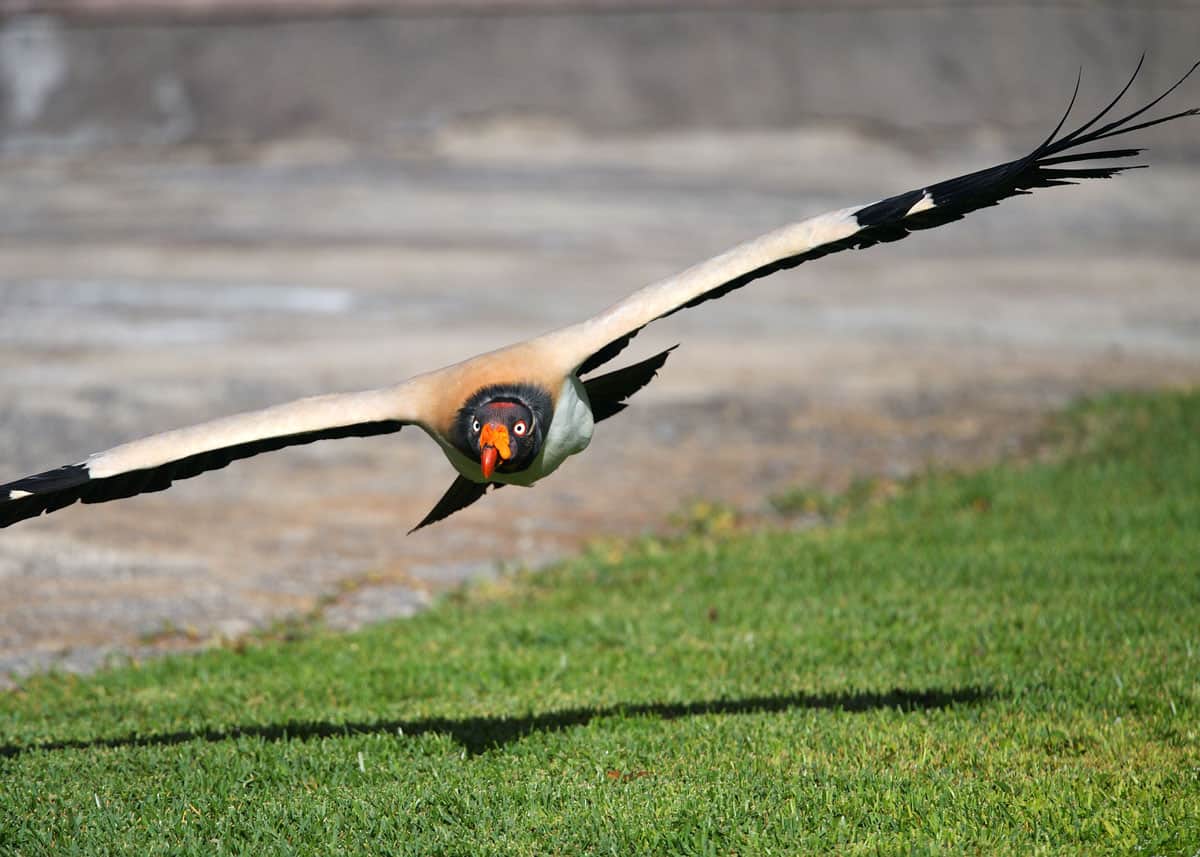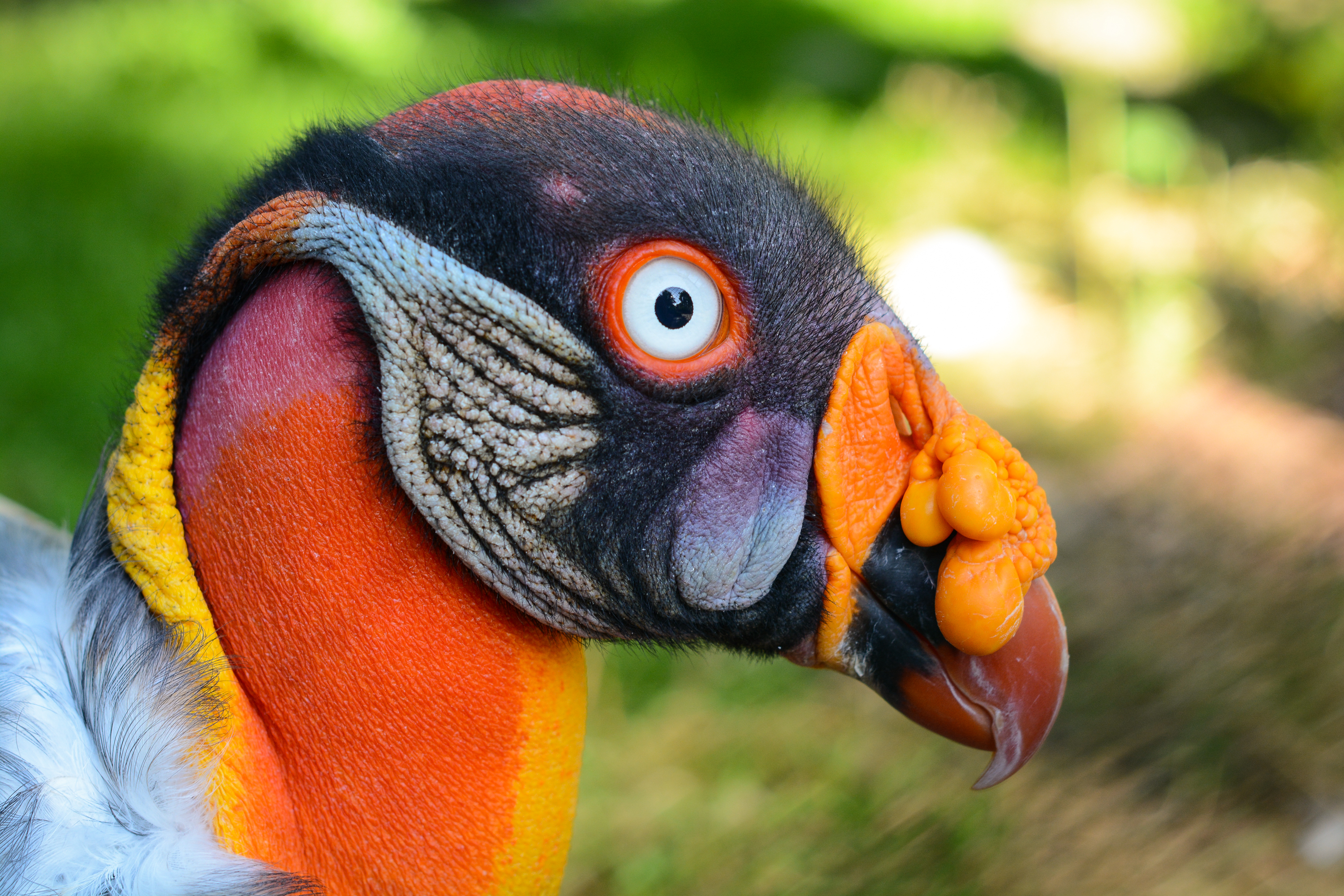The king vulture (Sarcoramphus papa) is a large bird found in Central and South America. It is a member of the New World vulture family Cathartidae. Like other vultures, the king vulture is a scavenger. These large birds glide on air currents, conserving energy while searching the forests or savanna below for the corpses of dead animals
The King Vulture is more colorful and appealing than other species of the Vulture. They have a wing span that can be up to 6 feet. They are fast, powerful, and have great vision. Their beak is more curved than other species of Vultures. It is also more powerful so they can get through even the toughest of animal carcasses to feed upon. The King Vulture may weigh from 6 to 10 pounds.

Sarcoramphus-papa | https://gringosabroad.com
Description Of The King Vulture
Their overall length ranges from 67 to 81 cm (26–32 in). The King Vulture has a cream or white color on the front of their body and the back. About half way down the back it turns into dark blue or black coloring. They do have white under the black but that won’t be visible unless they are in flight. They have a small head that is red in color. They have orange on beak and some areas of orange under the neck. The back of the neck is red.
The king vulture has, relative to its size, the largest skull and braincase, and strongest bill of the New World vultures. This bill has a hooked tip and a sharp cutting edge. The bird has broad wings and a short, broad, and square tail. The irises of its eyes are white and bordered by bright red sclera. Unlike some New World vultures, the king vulture lacks eyelashes. It also has gray legs and long, thick claws.
Habitat Of The King Vulture
King vultures live in the south of Mexico and throughout South America (Guyana, Venezuela) and Central America to northern Argentina. Mainly frequenting humid tropical forests, they may sometimes be seen in more open areas like savannahs and grasslands. These birds prefer undisturbed forests inhabited by large mammals.
Diet Of The King Vulture
They are carnivores and scavengers, eating carrion almost exclusively, including dead fish along the shores of streams.
Behavior Of The King Vulture
The king vulture soars for hours effortlessly, only flapping its wings infrequently. Despite its size and gaudy coloration, this vulture is quite inconspicuous when it is perched in trees.They usually lived up to 30 years in captivity, though their lifespan in the wild is unknown. The king vulture lacks a voice box, although it can make low croaking noises and wheezing sounds in courtship, and bill-snapping noises when threatened. They are rarely aggressive, even to other Vultures. As a result when this one comes along to eat other species of birds will typically leave the find. They don’t want to get into a confrontation with such a powerful bird.
Reproduction Of The King Vulture
King vultures are monogamous and their pair bonds last for life. They are often seen perching high in trees under cover, or soaring very high up in the sky. As a result, their courting ritual is only seen in captivity, being a display where both birds walk around on the ground in circles while they flap their wings. They make loud snorting and wheezing noises during mating. Breeding usually takes place during the dry season. These birds are solitary and so do not gather in big colonies to nest. Instead of building nests, they lay their eggs in a stump or the hollow of a rotting log or a crevice in a tree. A single egg is laid and incubation lasts for around 55 to 58 days, with both parents regularly taking turns. Chicks are naked when they hatch but very soon acquire pure white down. The parents bring food to them in their claws, but also feed their chick by regurgitation. Young fledge at 3-4 months, but remain dependent on their parents until they are eight month old and may stay close to them for two more years. At three to four years of age a chick has developed all its plumage and other features. Females become mature at around 5 years of age, and males at around 7 years of age.
11 Interesting Facts About The King Vulture
- King vultures have one of the strongest beaks out of all the American vultures, being able to open a carcass that the others cannot. This is why they often eat first, with the other vultures eating what remains.
- When it is too hot, the King vulture defecates on its legs, a cooling process called urohydrosis.
- The closest relatives to King vultures are condors.
- A King vulture is the third biggest of the vultures in the New World.
- After eating, King vultures will fly a long way to a river to bathe.
- Ancient Mayans knew the King vulture, including it their art. They named it “oc”
- Vultures can strip a carcass clean in minutes.
- Vultures are believed to mate for life, which can be 30 years in the wild.
- Charles Darwin called vultures “disgusting” with bald heads “formed to wallow in putridity”.
- Without vultures, carcasses would linger, insect population would boom, and diseases would spread.
- Vultures can vomit their entire stomach contents when threatened, the better to take quick flight.
King Vultures
They are scavengers and belongs to the vulture family Cathartidae. They can be found in Central America and South America (Guyana, Venezuela) and Northern Argentina. King Vultures feed exclusively on carrions but also eat dead fish along shores and streams. The King Vultures really do offer a necessary element in the balance of nature.
Article References:
- http://animalia.bio/king-vulture
- https://www.bioexpedition.com/king-vulture/
- https://en.wikipedia.org/wiki/King_vulture
- https://www.nationalgeographic.com/animals/birds/k/king-vulture/
Discover more from Things Guyana
Subscribe to get the latest posts sent to your email.







